Parables in Stained Glass (2)
Last month I showed how the Parables of the Foolish Virgins, the Talents, the Wedding Feast, the Sower, and the Prodigal Son had been depicted in stained glass. Here are some more of the thirty or so parables Jesus told.
In Matthew 13 Jesus told two similar parables about the Kingdom of Heaven being like treasure. In the second of these, the treasure is a fine pearl that the merchant sells everything to obtain. This fine window from the chapel at Kings College, Auckland, shows the merchant buying the pearl from the seller, with the pearl lugger in the background. To me, the message from these parables is simple - having found the Kingdom of Heaven, do everything to keep it.
The Parable of the Rich Man and Publican is beautifully told in these two windows from St Mary of the Angels, Wellington [2] and the chapel at Kings College, Auckland [3]. In both, the arrogance of the rich man contrasts with the humility of the publican. The text of the parable is partially quoted in the latter.
The Parable of the Widow’s Mite is depicted in this rather dark window[4] from St Stephen’s Uniting church, McQuarrie St, Sydney. Although this strictly may not be a parable, it is in a similar vein to the rich man and the publican, showing the value of humble dependence on God. The widow gave everything she had - should we not do the same, with a humble approach to Jesus using short prayers as did the publican? “Jesus, have mercy on me, a sinner”.
We all know the Parable of the Good Samaritan, having heard it read many times at Mass. There are four ‘cartoons’ in a big window in St Michael’s Church, Kelburn, Wellington. They show the traveller being set upon by brigands [5], passed by priests and Levites [6], tended by the Good Samaritan [7], and taken on the Samaritan’s donkey to the inn [8]. This is the way windows were done in medieval times, with huge windows featuring small cartoons mirroring and explaining scripture. The windows in Chartres Cathedral, France, are all like this, but you need binoculars to make them out.
I have more than twenty windows featuring the parable, far more than any of the others - which underlines its importance. To me, the parable has many layers. First - “who is my neighbour?” Jesus was asked. In Matthew 25:31 ff, Jesus says that when I do anything for someone in need, I do it for him. So my neighbour is anyone in need. How often have I passed a hitch-hiker and felt guilty because my wife doesn’t feel safe? Skirted round the beggar in the gutter? I need to see Jesus in them...
Back to the windows, there are many beautiful ones. Like this triple one from Old St Paul’s, Wellington [9]. In the left panel, see the two smaller figures in the background looking on, wringing hands, unable or unwilling to help. The central panel has the Samaritan struggling with the victim on a donkey, the right hand one beautifully portraying the Samaritan paying the innkeeper’s wife for whatever the victim needed, and the victim being cared for by a physician. Can you see yourself anywhere in the windows?
Most of the windows featuring the Samaritan tending the victim also feature two figures representing the priest and Levite (i.e. a temple helper) walking by. The window from St Mary of the Angels, Wellington [10] shows the passers-by very well, the priest busy praying, no doubt telling God how good he was compared to the wretch in the gutter, and the Levite lifting his skirts so he didn’t get contaminated. How often have I been in their shoes?
One window just showing the priest and Levite is in Sts Peter & Paul Church, Pieve Sestina, Northern Italy [11]. It struck me particularly, as it shows the priest and Levite together, and I can imagine them discussing how disgusting the poor victim is.
Lord, teach me to be a good neighbour, and treat people in need as yourself.

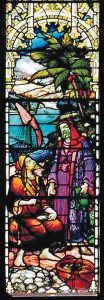
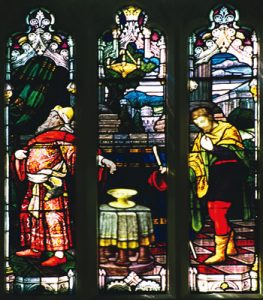
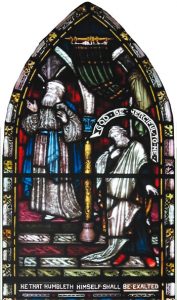
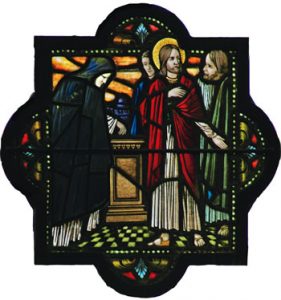
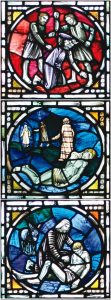
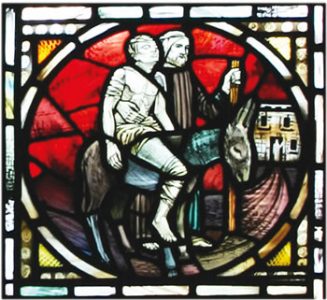
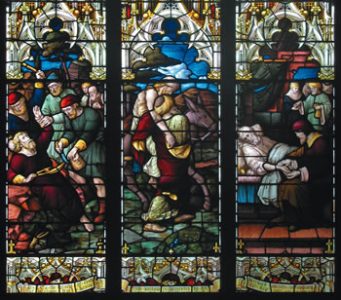
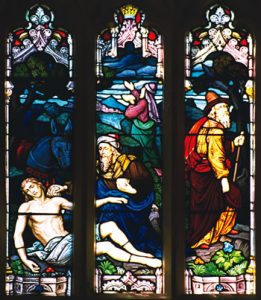
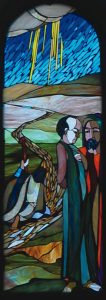
 Entries(RSS)
Entries(RSS)